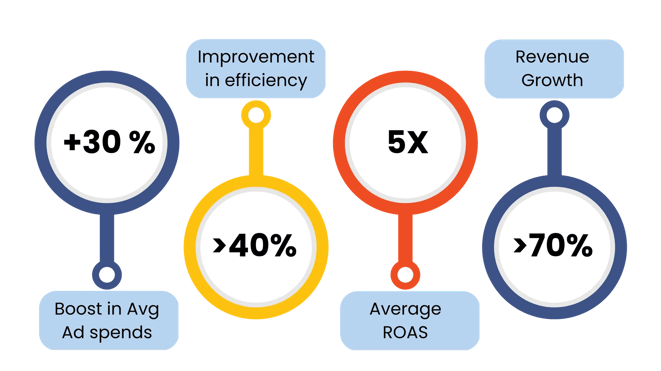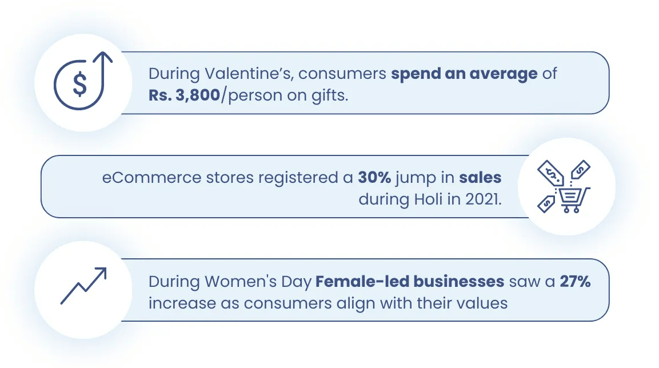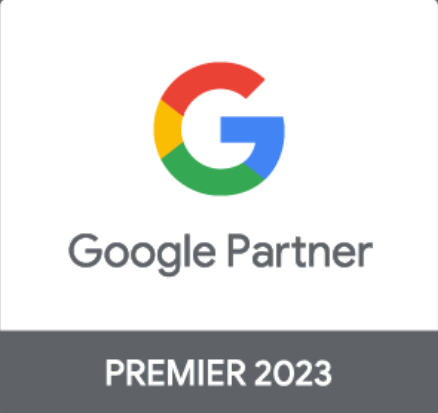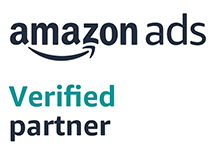As an ecommerce brand, you may think that the period from October to December is the only time when you can skyrocket your revenue. After all, the biggest festivals of the year - Diwali, Dussehra, Rakshabandhan, Christmas, and New Year's fall around this time, alluding it to be the most profitable for ecommerce brands.
However, some of the fastest growing eCommerce brands working with Adyogi like Rare rabbit, Shopmulmul, Silvertraq, Prerto, Kushal’s, Only, and 100+ have been able to crack the profitability code to make every quarter just as festive as Q3. How? By leveraging the power of micro events!
Micro events are often smaller, more intimate events that help to foster relationships between your business and potential customers. And contrary to popular belief, the first half of the year brings a wide range of opportunities with these “micro-events” like Valentine's Day, Holi, Women's Day, Mother’s day, and more.
Here are some of the key learnings that we’ve come up with from running micro events sales for our brands at Adyogi:

Understanding The Consumer
Before we dive into specific tactics, it's important to understand consumer behavior during this time of year. In general, the first half of the year is characterized by lower spending, as consumers recover from the holiday season and tighten their budgets. However, as the stats speak, there are plenty of opportunities to drive sales during this time -

Now that we know your consumers are interested in buying, let’s make you interested in selling your products with exciting offers!
How much can a brand expect to scale during the sale period?
During such micro event sale periods, brands can expect to scale up their revenue by up to 5 times as compared to their BAU activities. For instance, if a brand generates 18-20 Lakh of revenue on a regular day, they should aim to increase that to 65-70 Lakh during sales or events.
This is how you can grow your eCommerce revenue with micro events:
1. Inventory management: Identify and focus on hero products for the event/sale
-
Identify your Hero products and categories & push separate budget on those products e.g. for a fashion brand your hero product might be Shirts or T-shirts that get you more 30% + revenue.
-
Focus on specialized messaging for your event. The more you invest in customizing and niching down your messaging, the more your audience would be interest in knowing more. For example, your taglines like “Treat yourself this valentine’s day” .
-
Use custom overlays to boost your Ad CTR e.g. bells for Christmas.
-
The key to more revenue if boosting your AOV. One of the easiest and best ways is to promote gifting as a use case. Create gifting packages of your products and promote them separately.
2. Prepare your website to be sale-ready:
To make the most of a sale, optimizing your website is crucial.
-
By updating the hero banner with relevant themes and colors such as white, red, pink etc., you can attract potential customers who are planning to surprise their loved ones on special occasions.
-
Additionally, creating urgency by adding a sales end countdown will alert customers and encourage them to make a purchase before the sale ends.
-
PRO TIP : You can use terms like "Last Few Hours of Sale Left" or "Sale Extended on Heavy Demand" to create Urgency.
3. Create separate campaigns focusing on SALE
-
Drive traffic to category page that are sale/ occasion specific - e.g. Black Friday, Diwali, Holi etc.
-
Create a SALE conversions campaign with a separate ad set for each category that is on sale. Land the customers on category wise sale page.
-
Choose target audience based on the popularity of the occasions - e.g. Holi ads in the Northern states.
-
Run catalog linked ads on Discounted Products e.g. 40-50% OFF or >50% Off. Use minimum ROAS objective.
-
Leverage rules to scale-up budgets rapidly.
4. Utilize exciting offers and discounts to boost conversions
When it comes to ecommerce, sales are the perfect opportunity to attract new customers and retain loyal ones. To make the most out of your sale, it's important to offer enticing promotions and discounts that will catch shoppers' attention.
-
Some examples of effective promotions include limited-time offers, free shipping, percentage discounts, and bundle deals. You can create a compelling sale that encourages customers to buy more and return for future purchases.
-
Consider “No Returns only exchange” for sale products
-
There are many different types of sales that businesses can run, including flash sales, BOGO (buy one get one), B1 25% off, and more. Flash sales are a great way to create a sense of urgency and encourage customers to make a purchase quickly.
-
BOGO deals are effective in incentivizing customers to buy more products, while B1 25% off promotions can help increase the average order value.
-
Ensure discount percentage on the marketplace for the same set of products is not higher as compared to the brand’s own website during the sale.
-
Ecommerce brands can promote customized coupons like womensdayholi, superwoman, BFFsoulmate and offer discounts and free shipping over pre-paid orders.
5. Search Engine Optimization (SEO) and site link extensions:
-
SEO is a great way to get organic traffic to your ecommerce website. Optimize your website and content including product pages, category pages, page titles, page content, meta tags, product description, etc.
-
Incorporate high-value ad copies to improve conversions.
Try our Adyogi’s AI Ad text generator for high converting Ad texts for all ecommerce industries.
-
Use sitelinks extensions for better CTRs - promote your festive collections and promotions
-
Include concise and informative Frequently Asked Questions (FAQs) regarding returns, exchange, sellers, etc.
6. Optimize your Ad landing page
In order to optimize your ecommerce product and category landing pages for sale ads, it is important to plan your optimization strategy in advance.
-
Simplify your landing page design by using contrasting colors and keeping the important elements above the fold.
-
Utilize scarcity techniques and make your call-to-action buttons clear and simple.
-
In addition, add contact information to build trust with potential customers.
-
To further improve your results, test different headlines and copy.
-
You may update the performance max image with the offer.
-
Clearly showcase what is being offered to the visitor
-
Decrease page load time
-
Try different offers to get customer information.
7. Remarket all website, offline, and SM audience
- Remarket Website audience
a) Product page visitors
b) Cart abandoners
c) Website homepage and Category page visitors - Remarket Social Media audience.
a) Page visitors on Facebook and Instagram
b) Video view audience on social platform
c) Video view audience on YouTube
- Remarket customers with SMS, Whatsapp and Email
- Run Click-to-whatsapp ads to divert traffic to Whatsapp. Enable add-to-cart, checkout & payment within Whatsapp.
8. Run Hygiene Check across social media channels :
-
Update your community of the upcoming event across all social media channels.
-
Start a new hashtag campaign for your event. For example to promote their spring collection launch, Mulmul launched #HappinessSale
-
Add product videos wherever possible to give a 360-degree view to your audience
-
Add User Generated Content, ask for feedback, ask for reviews
-
Over 65% of buyers rely on influencers to get inspiration for gifting ideas, so it’d be wise to include micro, macro and even nano influencers in your Ads.
-
Respond to all of your messages to gain customer attention.
Final Thoughts
While Q3 and Q4 are certainly the most profitable times of year for ecommerce brands, we’ve seen eCommerce brands generate 3x of BAU during micro-event during the former part of the year.
The key to profitability is to invest in thought-driven planning and data-backed advertising campaigns. eCommerce brands can take advantage of Adyogi’s comprehensive performance automation tool to scale their revenue in Q1 and Q2.
Use our advanced automations like Single-click Ad population across different channels, Stop-loss for underperforming products, Pre-defined category smart Ads, Funnel-tracking optimizations, etc to make 2023 a profitable year for your eCommerce business.
Book a call to know more.





-1.png)






